A few years ago, I took a short boat tour off the coast of Hawaii. As Murphy's Law would have it, our ship was hit by a major typhoon. It seemed like the typhoon lasted for an eternity and when it was over we found ourselves washed up on a deserted tropical island. Unfortunately, our GPS and ship-to-shore radio was destroyed during the typhoon. We had no means of communication to the outside world and we didn't even know where we were located. Somehow, we had to use the local materials to develop an emergency transceiver. I thought that I would document this design in case you ever find yourself in a similar predicament.
The receiver: As you review this reference design, please remember that we only had to work with the local plants and minerals from the tropical island. The objective of the receiver was to keep it simple and build a single diode AM receiver. Figure 1 shows the schematic for the receiver. Although the design seems relatively straight forward, the problem was that we did not have any wire, resistors, capacitors, diodes, or earphones. Fortunately, we were able to construct these circuit elements using local resources. This section will provide how-to guide for building these elements.
Figure 1: Simple One Diode AM Receiver
Coconut shell diode: Probably the most challenging problem we had to overcome was to develop a semiconductor diode. As luck would have it, however, the coconut fruit is actually a pure semiconductor (see Figure 2). Furthermore, sea salt and lime make excellent P and N type doping impurities (see Figure 3). You might wonder why the simple coconut diode isn't used commercially. The answer is simply that coconut has a limited shelf life.
Figure 2: Excerpt from periodic table
Figure 3: Coconut Shell Diode
Clam shell capacitor: The clam shell capacitor is also worth noting because it makes an excellent natural capacitor. The top and bottom shells act as a parallel plate capacitor, and the capacitance can be easily adjusted by opening or closing the shell to varying degrees. Figure 4 shows the clam in two different positions and the associated capacitance. Please note that the voltage coefficient of a clam shell capacitor is extremely low which minimizes distortion. In fact, I think the clam shell capacitor should be used in commercial high fidelity audio applications.
Figure 4: Capacitance vs. Clam Opening
All the rest of the components: The remaining components are common applications of tropical flora, and consequently, we will not focus on these. For further information, consult the Electrical Characteristics for Flora and Fauna in Tropical and Subtropical Regions [3].
The transmitter: Figure 5 illustrates the simple transmitter design that we used to call for help. This section of the reference design provides details on the components used in the transmitter.
Figure 5: Schematic Diagram of Simple AM Transmitter
Gourd amplifier: It was of key importance that the transmitter had sufficient power to transmit long distances. The gourd from the talahoobaloo tree is an excellent natural amplifier. Typically, the voltage gain of this gourd is between 1,000 and 10,000. The power output is strictly dependant on the batteries connected, so we placed 100 limes in parallel.
Coconut microphone: Considering the principle of reciprocity, it can be shown that a coconut not only acts as an excellent earphone, but also can be used as a microphone. In fact, the coconut approximates an electret microphone and can be modeled as such.
Crystal oscillator: The crystal oscillator was fashioned out of a piece of quartz found in the islands cave. Unfortunately, one of the members of the castaway group was captured by some natives and boiled in a large caldron of water. Fortunately, the natives became distracted when the island's volcano erupted and he was able to escape with the needed crystal.
Final outcome: I am happy to say that the transceiver worked quite well and we were rescued a few months after the typhoon. We were all very happy about the rescue as we were getting sick of coconut cream pie, coconut on a stick, and fried coconut. Unfortunately, we were fined by the FCC for violating AM transmission power restriction. It seems that the lime batteries were even more powerful that we expected. Nevertheless, I hope you can make use of this design in the eventuality that you ever end up stranded on a deserted island. (See Figure 6 and Figure 7).
Figure 6: Photograph of Transceiver with its Components Labeled
Figure 7: Operation of the Transceiver
References:
- Wenzel, Charles, "Crystal Radio Circuits," Crystal Radio Circuits, TechLib.com, 1995
- Field, Simon Quellen, "Building a very simple AM Voice transmitter," Building a very simple AM Voice transmitter
- Hinkley, Professor Roy, BA, BS, MA, PhD, Electrical Characteristics for Flora and Fauna in Tropical and Subtropical Regions, Island Press, New York, 1964
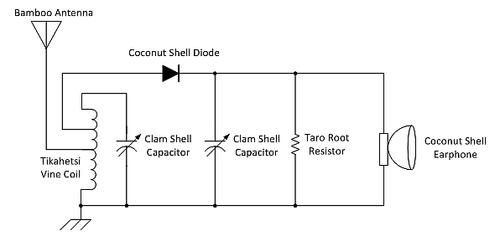

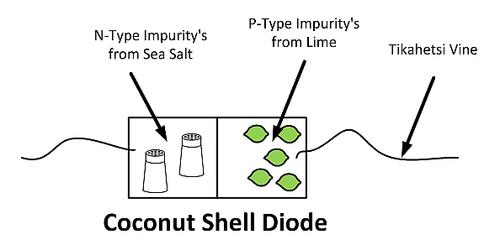
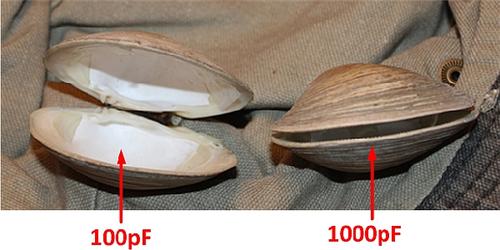
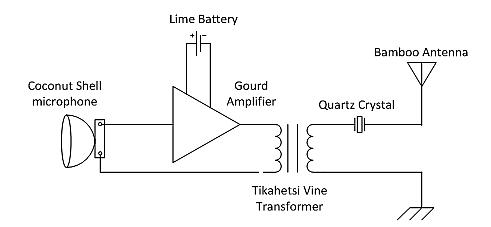
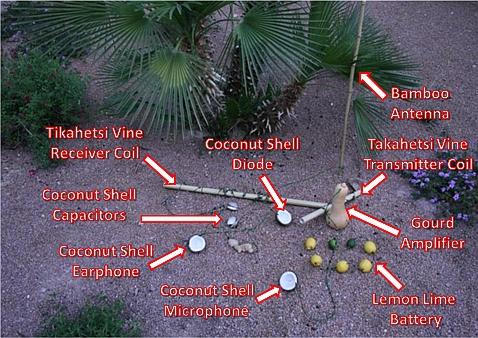
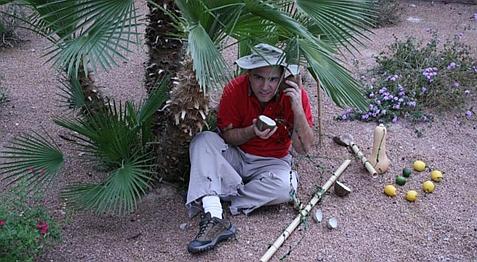
I think it's worth giving a try. Very challenging!!
ReplyDelete